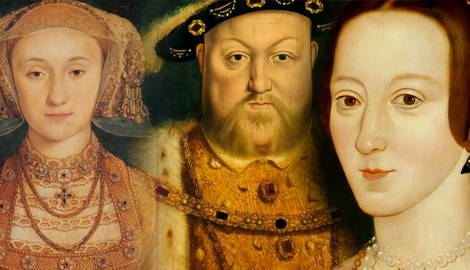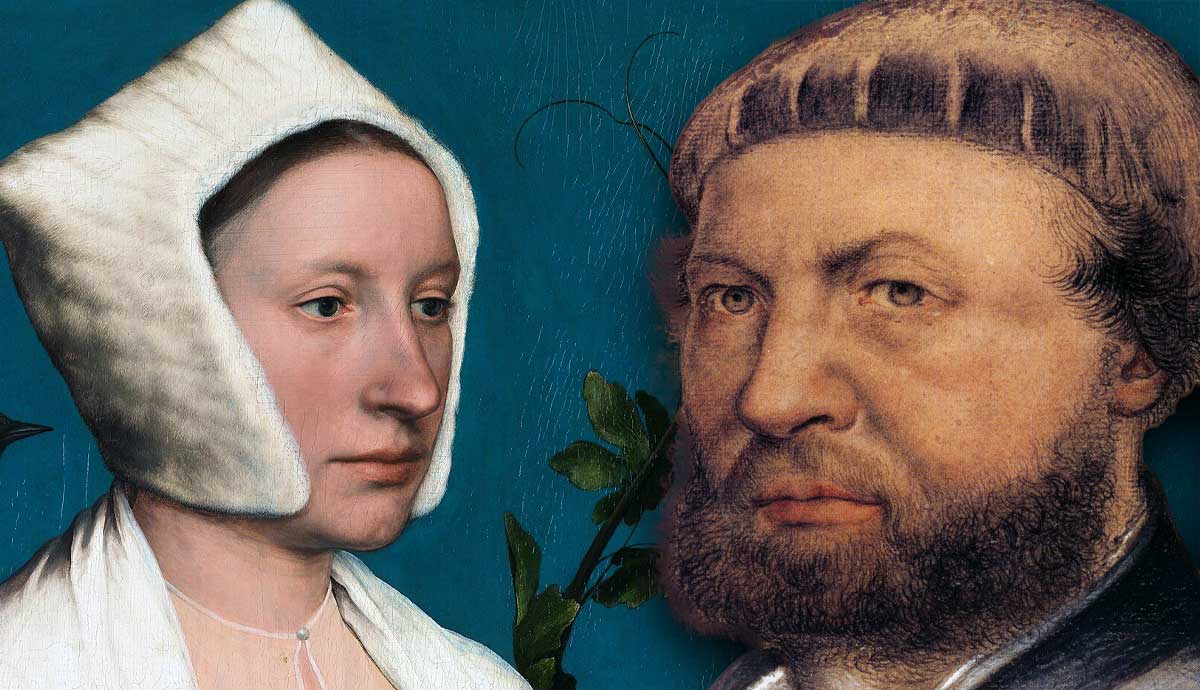
King Henry VIII is known for marrying six times during his lifetime. It is no secret that marrying Henry VIII was a recipe for disaster. In 1538, Henry VIII was searching for a fourth wife, hoping to make a diplomatic marriage with a woman from the European noble courts. However, he was worried that a diplomatic marriage may mean marrying a woman to whom he was not attracted. To remedy this, he sent one of his most prominent court artists to paint potential wives and bring their portraits back to England for the King to choose.
The Death of Henry VIII’s Favorite Wife

Henry VIII has gone down in history for his many marriages, all of which would end badly. His third wife, Jane Seymour, was his favorite wife. He maintained Jane as his favorite and most beloved wife until his death, even weeping for the loss of her in his final days. She was the Queen who gave him his long-awaited heir to the throne, the future King Edward VI. Sadly, however, she would pass away shortly after the prince’s birth.
Jane’s death hit Henry especially hard. As custom dictates, he was not to attend the funeral, which took place at St. Paul’s Cathedral in London. He anguished over his loss for weeks before moving to Whitechapel to take up his kingly duties again. Despite getting back to work, he was understandably devastated. Nonetheless, England was now without a Queen. An heir was wonderful news for Henry, but he knew better than anyone that he needed more than a single son to guarantee the continuation of the Tudor dynasty. He, himself, was never raised to be King and only happened to become King after the death of his older brother. Finding a new Queen was a matter of state, and his counselors urged him to consider a foreign bride from one of the various courts of mainland Europe.
Hans Holbein’s Travels

Though Henry kept the court in mourning until Easter the following year, he agreed that England needed a new Queen and that a foreign bride could provide a protestant alliance for England. Henry worried that if he married for diplomatic reasons, his wife might be unattractive. To ease his worries, he decided to send one of his most trusted artists to the various courts of Europe. There, he was entrusted with recording the beauty of potential wives as realistically as possible to bring back to England so the King could see his options. Hans Holbein the Younger was the right person for the job, as he was known for the hyperrealism in his work.
In 1538, Holbein set sail for Brussels to meet the Danish princess, Christina of Denmark. Christina was a 16-year-old girl, known for being a beauty among the nobles of Europe, who had recently been widowed after the death of her first husband, Francis II, Duke of Milan. Marriage proposals flooded in, including one from the English King Henry VIII.
Christina of Denmark’s Portrait

Henry’s proposal was considered, but it was not favored by Christina nor her aunt and guardian, Mary of Hungary. Mary of Hungary had previously written in a private letter, “I hope that the English will not do us much harm now we are rid of the King’s mistress, who was a good Frenchwoman, and whom, as you have no doubt heard, has been beheaded.” This was a comment on the beheading of Anne Boleyn, the news of which had shocked Europe.
She continued, “I hear he has married another lady, who is said to be a good Imperialist, although I do not know if she will remain so much longer. He is said to have taken a fancy to her before the last one’s death, which, coupled with the fact that neither the poor woman nor any of those who beheaded with her, save one miserable musician, could be brought to acknowledge her guilt, naturally makes people suspect that he invented this pretext to get rid of her.” Clearly, Henry VIII’s past actions had gained him a reputation that made potential brides and their guardians wary.
Henry’s ambassadors knew of his reputation and attempted to woo Christina by showering their King’s character with compliments while in Brussels. Christina must have had strong reservations about the marriage. She is said to have laughed at the comments about the King’s exemplary character. She allegedly said “If I had two heads, I should be happy to put one at the disposal of the King of England,” though this quote is highly debated and likely to be a legend created after her death. In reality, Christina was known for her demureness and was described as of few words.
Preparatory Sketches

The portrait of Christina of Denmark was not created in Brussels. It is noted in contemporary sources that Holbein sat with Christina for only three hours, creating a preparatory sketch to take back to England, which he could then turn into a large-scale painting. Upon returning to England, Henry VIII was presented with the preparatory sketch. His reaction must have been a great relief to Holbein. Henry lit up with joy at seeing the drawing of the woman that could someday be his bride.
He was so impressed by the drawing that he immediately ordered a full, life-size painting of Christina. Upon receiving the painting, he was put into such a jolly mood that he ordered court musicians to play for the rest of the day. He kept the preparatory drawing and the finished painting for the remainder of his life, so that he may always gaze upon her beauty.
The preparatory drawing no longer exists, but we have many others created by Holbein that can give us a sense of what they might have looked like and how Holbein may have used these drawings to create paintings. In the drawing above, we can see Margaret Giggs, the foster daughter of Sir Thomas More. The drawing would eventually be used in a portrait of Thomas More’s family, closer to the beginning of Holbein’s career in England. Thomas More was instrumental in getting Holbein work in England. They had a mutual friend, Erasmus of Rotterdam. Erasmus supported Holbein’s work and recommended him to his friend in England, Sir Thomas More. Through this connection, Holbein found work in England and eventually raised himself to the King’s Painter, an official court artist.
Portrait of Anne of Cleves

When the King received news that Christina of Denmark would not marry him, he sent Holbein back to mainland Europe to paint a new candidate. This time, he did not return to the court of Mary of Hungary but to a small German duchy called Cleves. Here, he was to paint the noble sisters, Anne and Amalia of Cleves, as accurately as he could. Application portraits of Anne were already being passed around Europe, and Henry himself had seen them.
He found them unsatisfying and needed Holbein to paint them so that he could get a trustworthy and accurate representation of the sisters. When Holbein arrived in Cleves, he found Anne uneducated and stiff, yet a virtuous woman nonetheless. She was considered of middling beauty, according to a French ambassador who was also present during her marriage negotiations.
To make up for her lack of outstanding beauty, Holbein needed to show her strengths as a potential Queen in other ways. To do this, he focused on the fine details of her apparel, giving her a grand and rich look that would entice the King to find her attractive. Holbein knew that his career in England depended on the King’s trust in him, and to lose that trust would be to lose his job, or worse, his life.
Holbein needed to paint her as accurately as possible while making her appealing to the King’s eyes. The best way for him to accomplish both goals was by focusing on her clothing and making her appear as sophisticated and Queenly as possible. Holbein painted her in a forward-facing position, rather than the standard half-turn pose used in portraits at the time. Jewels line her clothing. Her throat is draped in necklaces. She wears an elegant hood over her hair. These qualities were meant to show the King her potential as a bride and Queen.
Henry VIII and The Outcome of Anne of Cleves

Holbein’s visual negotiations paid off, and Henry VIII chose Anne of Cleves as his fourth wife. Marriage preparations began, and she traveled to England at the end of 1539. There were plans of an official welcome in London, but the King wanted to play at chivalry and rode to her under disguise to test if the match was true love. When the middle-aged King arrived unexpectedly wearing a mask, he attempted to kiss her. Unsurprisingly, she pushed him away for his behavior, unaware that the man she was rejecting was her future husband and the King of England. After this occurrence, the King decided he did not like his new wife and complained to his companions about her.
After months of hearing his advisors speak of her so highly in hopes that they might gain royal favor, the King commented, “I see nothing in this woman as men report of her.” He was angry with his advisors and Holbein for the situation he had found himself in. It was too late to back out of the marriage, as the marriage would seal an alliance between England and Cleves, and to do so after Anne’s arduous and expensive journey to England could mean political retaliation from Cleves. The marriage took place on January 6th, 1540. Henry was upset about his new wife and never consummated the marriage. In July of the same year, it was annulled so that he could pursue his fifth wife, the teenage Catherine Howard.

In an attempt to reduce anger from Anne’s brother in Cleves, he made Anne his official sister at court. In this role, she would be the highest-ranking woman in England besides the Queen and his daughters. Because she willingly went along with the divorce, Henry expressed his gratitude by gifting her multiple properties and lands, including Hever Castle in Kent, the childhood home of his second wife, Anne Boleyn.
Many historians believe that Anne of Cleves was the luckiest of Henry VIII’s wives, with her willingness to accept divorce awarding her a life of luxury and status in England without the danger of being King Henry VIII’s wife. It is noted that Anne sometimes commented in private that she should be the Queen, but never fought the matter and seemed content to do the King’s bidding by remaining his official sister.
Holbein fell from the King’s favor but remained in England as an official court artist. Many art historians believe that the fact that the King did not remove him from court means that Holbein’s portrait of Anne was accurate, even if the King changed his mind about her after their awkward first encounter. It is possible that Holbein went to Switzerland to visit his family in 1540, which could have been enough time for the King to cool down and come to his senses. Nonetheless, Holbein was an integral part of Tudor England’s history, and the portraits of Christina of Denmark and Anne of Cleves still exist to be admired today, just as Henry VIII did centuries ago.










